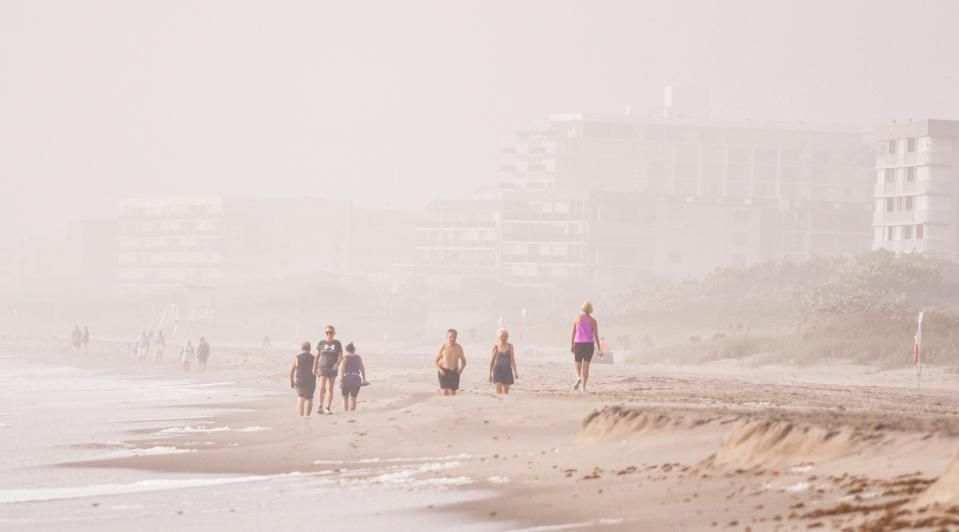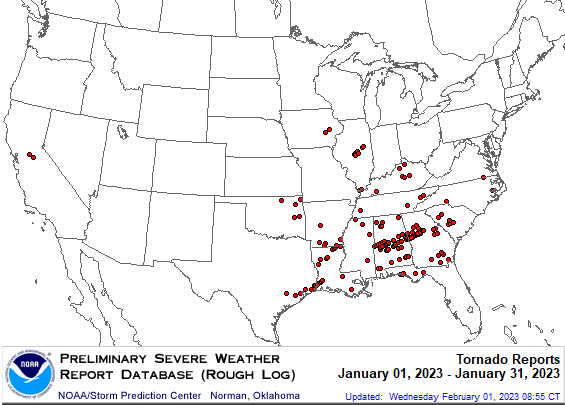How many of AccuWeather's most impactful weather events of 2023 affected Florida?
AccuWeather has released its top 10 list of the "most impactful weather events of 2023" and Florida wasn't ignored, unfortunately.
Florida felt the impact of several of the events, including the only hurricane that made landfall in the U.S. during the year and record heat. As if that weren't enough, smoke from Canadian wildfires managed to make its way as far south as Florida.
Guess that shouldn't totally surprise us since we're used to Saharan dust moving across the entire Atlantic Ocean from Africa.
Here are the top 10 weather events selected by AccuWeather:
Hurricane Idalia slams Florida's Nature Coast
Hurricane Idalia was the only hurricane to make landfall in the U.S. in 2023.
It made landfall as a Category 3 hurricane with maximum sustained winds of 125 mph at 7:45 a.m. Aug. 30 near Keaton Beach, in Florida's Big Bend. Storm surge of 7 to 12 feet and widespread rainfall flooding hit Florida and spread across the Southeast, according to the National Weather Service.
The storm weakened slightly before landfall. Hours before, Idalia was expected to hit as a Category 4 storm, with maximum sustained winds of at least 130 mph.
There was one direct fatality that occurred in Madison County during Hurricane Idalia from a falling tree, the National Weather Service reported. Overall, Idalia caused seven direct and three indirect deaths in the U.S.
Smoke from Canadian wildfires blankets U.S., including Florida

Wildfire smoke from the far northwestern Canada created hazy conditions as far south as Palm Beach County in October, reducing visibility and triggering an air quality alert from health officials.
The smoke, which hitched a ride on a clockwise swirl of winds from an area of high pressure over the Mid-Atlantic region, stuck around for a few days before moving into the Gulf of Mexico.
Florida experienced some of the heaviest concentrations of smoke in early October — and a spike in unhealthy air quality that ranked the worst in the country — because of north and northeasterly winds from a system of high pressure.
An orange alert was issued Oct. 3 by the National Weather Service for portions of the state, warning residents the air quality affected by the lingering smoke is generally unhealthy for people with sensitivities to smoke and other pollutants. They were encouraged to stay indoors until the smoke dissipated.
Hurricane Lee stirs up rough surf, dangerous rip currents along East Coast

While Hurricane Lee didn't directly threaten Florida’s East Coast, it still brought rough surf and dangerous rip currents in September.
The threats remained for several days as the storm moved north before making landfall in Nova Scotia.
Swells generated by Lee affected thousands of miles of the Atlantic Coast. Large swells were reported in Puerto Rico, Hispaniola, the Turks and Caicos Islands, the Bahamas, Bermuda, the East Coast of the United States and Atlantic Canada, the National Hurricane Center said.
Some areas along Florida's east coast were expected to see breaking waves build to between 6 and 8 feet.
Lee claimed two victims, a teenager who drowned off Fernandina Beach amid rough seas churned up by the hurricane and a 51-year-old man killed by a falling tree branch in Maine.
Florida tops several heat records during hottest year in recorded history
It's been warmer than at any time in recorded history and was likely warmer than any other time in 125,000 years, an analysis by Climate Central concluded in November.
On Nov. 17, the globe briefly hit an average temperature of 3.6 degrees Fahrenheit above pre-industrial levels for the first time in recorded history.
Heat-related records were set and broken, over and over again, month after month and year after year in cities, states and countries around the world.
Record high temperatures were set time and again across Florida in 2023.
According to weather data from Naval Air Station Jacksonville, the heat index reached 100 degrees on 27 straight days in July.
Three states saw their hottest August on record — Florida, Louisiana, and Mississippi, according to Yale Climate Connections. That followed the hottest July on record for Florida.
Texas, Louisiana, Mississippi and Florida each ranked warmest on record for the period of January through October, according to NOAA.
Record warmth in the Atlantic Ocean made for an above-historical average hurricane season despite a building El Niño.
El Niño nears historic strength
El Niño officially developed in early June and gradually intensified as the year progressed, according to AccuWeather.
El Niño usually helps suppress tropical activity in the Atlantic basin, but unusually warm water across the Atlantic Ocean overpowered it.
The 2023 Atlantic hurricane season was the fourth busiest season since 1950.
There were 20 named storms. Seven became hurricanes and three intensified to major hurricanes with sustained winds of at least 111 mph, NOAA said.
An average season has 14 named storms, of which seven are typically hurricanes.
AccuWeather meteorologists said El Niño will have a bigger influence on the weather across North America through the start of 2024.
Record-breaking January tornado outbreak

There were a 168 tornadoes reported over two outbreaks, more than triple the historical average for January, setting a new record for the month, according to AccuWeather.
On Jan. 24, a tornado outbreak occurred from coastal Texas to the Florida Panhandle causing significant damage. Three tornadoes were confirmed in the Florida Panhandle.
Drought-busting atmospheric rivers unload record-breaking snow
Following what California Gov. Gavin Newsome described as a "megadrought," a series of nine atmospheric rivers, starting in late December 2022 through mid-January 2023, dropped feet of rain and yards of snow across California and other parts of the West Coast, AccuWeather said.
Twelve people were found dead in Southern California's San Bernardino County a week after back-to-back winter storms dropped over 100 inches of snow in some locations.
Deadliest US wildfire in more than a century sweeps through Maui, Hawaii
The Lahaina fire is the deadliest in the U.S. in more than a century. Caught in a hellscape, some residents died in their cars, while others jumped into the ocean or tried to run for safety. The Aug. 8 blaze reduced much of the historic town to ash.
The fire killed at least 106 people and all but incinerated Lahaina, destroying every building in the town of 13,000, according to AccuWeather.
Violent EF4 tornado rips through Mississippi, killing 17
"On March 24, two dozen twisters touched down across the Southeast, including the deadliest and one of the year’s most violent tornadoes," according to AccuWeather.
"The EF4 tornado ripped through Rolling Fork, Mississippi, and claimed the lives of 17 people, including a couple killed by a large semi-truck that was tossed into their home."
Peak wind speeds were estimated at 170 mph.
Most notable tornado outbreak of the year
"The most notable tornado outbreak of 2023 was the deadly and now historic outbreak that impacted large portions of the Midwest, South, and East U.S. on March 31 and April 1," according to AccuWeather.
The year's second and final EF4 tornado was one of 122 twisters reported across multiple states.
It was the fourth-largest tornado outbreak in U.S. history, AccuWeather reported.
This article originally appeared on Treasure Coast Newspapers: AccuWeather top 10 weather events. Florida impacts by hurricane, heat

